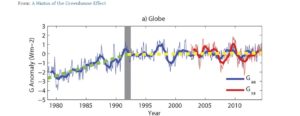by C. Blaisdell, Apr 6, 2025 in WUWT
Abstract
In addition to WUWT, more and more web sites are mentioning cloud reduction as a source of climate change, but offer no source of the cloud reduction. WUWT was the first to published this author’s theory: Cloud Reduction Global Warming, CRGW, (1). A critical part of CRGW theory is the relationship between Vapor Pressure Deficet, VPD, and Cloud Fraction. The relationship is logical: as the atmosphere’s water vapor concentration approaches the due point the probability of cloud formation should increase.
Previous papers by this author have shown that Vapor Pressure Deficit and cloud fraction are loosely correlated (low R^2). The measurement of cloud fraction seems to be the main uncertainty. This essay will show that downwelling Short Wave, SW, radiation to the earth’s surface along with atmospheric enthalpy, En, correlate to Cloud Fraction, CF, thus increasing confidence in VPD as a predictor of cloud fraction. VPD and En are necessary variables in the Cloud Reduction Global Warming , CRGW, model which models current climate change using Clausius–Clapeyron related equations.
Slicing the earth’s data reveals the change in atmospheric VPD and En vs latitude correlate to cloud fraction. The earth’s slices suggestion that lower land cover in a slice may be related to cloud cover in addition to the expected sun angle.
But, CO2 and VPD are confounded. Which one is guilty of climate change?
…





